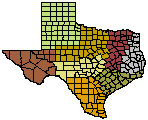- Trans Pecos
- High Plains/Panhandle
- Cross Timbers
- Hill Country
- Post Oak Savannah
- Pineywoods
- Oak Prairie
- South Texas Plains

Wildlife Division District Map
Pineywoods Wildlife Management
Endangered Species
Recovery Efforts
Despite the problems facing the Red-cockaded Woodpecker, recovery efforts are proceeding on private, state, and federal lands. State and Federal agencies are working with private landowners interested in developing Red-cockaded woodpecker conservation and habitat management plans for their property. Efforts are also underway to create corridors of continuous habitat or chains of high quality habitat islands between populations to facilitate exchange of birds and enhance opportunities for reproduction. Conservation and habitat management, providing information to landowners and the public, and monitoring woodpecker populations are all important parts of the recovery process.
Red-cockaded Woodpecker populations on all four National Forest are increasing as a result of habitat improvements (removal of midstory vegetation), insertion of artificial cavities (nest boxes placed on the inside of the tree), and augmentation (moving young females and males to single bird clusters in an effort to start new clusters). Recent techniques such as artificial cavities and augmentation are helping to prolong the useful life of some cavities, to create man-made cavities where suitable natural cavities are limited, and to address short-term problems of isolation and fragmentation.
Where to See Red-cockaded Woodpeckers
A number of state and federal properties offer opportunities to see and learn more about Red-cockaded Woodpeckers. These include the Alabama Creek, Bannister, and Moore Plantation Wildlife Management Areas; the Jones and Fairchild State Forest; the Sam Houston, Davy Crockett, Angelina, and Sabine National Forest, the Alabama-Coushatta Indian Reservation; and the Big Thicket National Preserve.
How You Can Help
You can be involved with the conservation of Texas' nongame wildlife resources by supporting the Special Nongame and Endangered Species Fund. Special nongame stamps and decals are available at Texas Parks and Wildlife Department (TPWD) field offices, most state parks, and the License Branch of TPWD headquarters in Austin. Conservation Passports, available from TPWD, are valid for one year and allow unlimited access to most State Parks, State Natural Areas, and Wildlife Management Areas throughout Texas. Conservation organizations in Texas also welcome your participation and support. Finally, you can encourage and support private landowners who are managing their land to protect endangered species and their habitat.
For More Information Contact
Texas Parks and Wildlife Department
Endangered Resources Branch
4200 Smith School Road
Austin, Texas 78744
(512) 912-7011 or (800) 792-1112
or
U.S. Fish and Wildlife Service
Ecological Services Field Office
10711 Burnet Road, Suite 200
Austin, Texas 78758
(512) 490-0057
Management guidelines are available from the Texas Parks and Wildlife Department and U.S. Fish and Wildlife Service for landowners and managers wishing to manage timberlands to benefit Red-cockaded Woodpecker.
References
Carpenter, J., and T. Hayes. 1991. Managing forest for Red-cockaded
woodpeckers-guidelines for private landowners in southeast Texas. Texas
Nature Conservancy.
Conner, R.N., D.C. Rudolph, D.L. Kulhavy, and A.E. Snow. 1991.
Causes of mortality of Red-cockaded woodpecker cavity trees. J. Wildl.
Manage. 55(3):531-537.
Conner, R.N., and D.C. Rudolph. 1991. Effects of midstory
reduction and thinning in Red-cockaded woodpecker cavity tree clusters.
Wild. Soc. Bull. 19:63-66.
Costa, R. 1992. Draft Red-cockaded woodpecker procedures
manual for private lands. U.S. Fish and Wildlife Service. Atlanta, GA.
35 pp.
Hooper, R.G, A.F. Robinson, Jr., and J.A. Jackson. 1980. The
Red-cockaded woodpecker: notes on life history and management. USDA Forest
Service, General Report SA-GR 9.
Ortego, B., M. Krueger, and E. Barron. 1995. Status and management needs of Red-cockaded woodpeckers on state and private land in Texas. Pp. 477-481, in Red-cockaded woodpecker: recovery,ecology and management (D.L. Kulhavy, R.G. Hooper, and R. Costa, eds.). Center for Applied Studies in Forestry, Stephen F. Austin State University, Nacogdoches, 551 pp.
Rudolph, D.C., and R.N. Conner. 1991. Cavity tree selection by Red-cockaded woodpeckers in relation to tree age. Wilson Bull. 103(3):458-467.
Rudolph, D.C., R.N. Conner, and J. Turner. 1990. Competition for Red-cockaded woodpecker roost and nest cavities: effects of resin age and entrance diameter. Wilson Bull. 102(1):23-36;
Swepston, D. 1980. Results of Red-cockaded woodpecker research in Texas between 1969 and 1973. Species Report. Texas Parks and Wildlife Department, P-R Project W-103-R-9.
U.S. Fish and Wildlife Service (USFWS). 1985. Red-cockaded
woodpecker recovery plan. USFWS, Endangered Species Office, Atlanta, GA.
 (
(